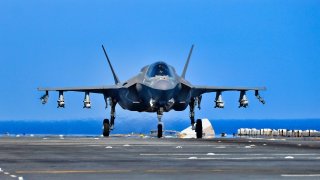The F-35 Has One Problem That Can't Be Solved
Summary: The F-35 Joint Strike Fighter, lauded for its advanced capabilities and role as a fifth-generation fighter, faces criticism for one significant limitation: its range
Summary: The F-35 Joint Strike Fighter, lauded for its advanced capabilities and role as a fifth-generation fighter, faces criticism for one significant limitation: its range. The F-35 variants—A (Air Force) and C (Navy)—offer a range of 1,200 nautical miles, while the B variant for the Marine Corps reaches only 900 nautical miles. This stands in contrast to longer-range aircraft like the F-22 Raptor and the F/A-18 Super Hornet, which boast ranges of 1,600 and 1,800 nautical miles respectively. This limitation is crucial for operations involving Carrier Strike Groups and Marine Expeditionary Units, especially in vast open ocean expanses where operational success depends on range and fuel economy for mission engagement and return.
The F-35 Has A Challenge It Can't Easily Fix: A Range Problem
The F-35 Joint Strike Fighter seems to have developed from a problem-plagued development program into a reliable, everyday fifth-generation fighter.
Today, the F-35 operates as it was designed to. Yet, as some critics have pointed out, it was designed to operate in a way that hobbles the US military strategy.
Namely, the F-35 suffers from a short range.
“The A and C [F-35] variants, employed by the Air Force and Navy respectively, have ranges of 1,200nm while the B variant for Marine Corps can only manage 900nm,” Maya Carlin wrote for The National Interest. “By comparison, the F-22 Raptor can reach 1,600nm while the F/A-18 Super Hornet maxes at 1,800nm.”
For a Carrier Strike Group based F-35C, or a Marine Expeditionary Unit based F-35B, operating in the vast expanses of the open ocean, range becomes vital to operational success. And while 1,200, or 900, nautical miles may sound like a lot, remember that range and fuel economy must be budgeted engaging in the mission itself (which is often fuel intensive), and returning to the ship after the mission.
So, 1,200 nautical miles means that the F-35-launching ship must be well within a 1,200-mile radius – which is becoming more and more dangerous as defense technology improves.
F-35 Limited Range Places Ships in Danger
The problem with the F-35’s limited range is that it draws Navy and Marine Corps ships closer to shorelines, closer to enemy defense hubs, further within the range of detection technology, and tracking technology, and missile systems.
In a conflict with, say, China, the US would be dependent upon their carrier and MEU fleets to deliver airpower, to control the airspace above wherever the conflict was being waged. Aircraft like the F-35 would be vital to the outcome of the conflict.
However, the limitations of the F-35’s range increase the vulnerability of vessels launching the ships, in part because the Chinese can narrow their search range when hunting the vessels.
One of the primary defensive measures of large vessels like aircraft carriers is the ability to hide in the open ocean. The further the range enemy targets, the larger the search radius that the enemy must search within to find the ship. The more constricted the target radius becomes, the easier the ship becomes to find.
And, of course, the closer to shore US ships must travel, the closer they are to enemy missiles.
“China has invested in conventional cruise missiles and medium to long-range ballistic missiles with an eye on denying the U.S. Navy, particularly its carriers, the freedom to operate in the South China Sea and beyond,” Carlin wrote. “For Air Force F-35s based in Japan and Korea, the transit to a potential flare-up around Taiwan would put them at the bleeding edge of their operational range.” What about aerial refueling? “Every variant of F-35 can have its range extended by aerial refueling, however, these tanker aircraft are incredibly vulnerable and the farther they can be kept from any frontline conflict the better.”
So, while the F-35’s range is not a fatal flaw, it does make the aircraft’s, and the aircraft’s support team’s, job harder.
About the Author: Harrison Kass
Harrison Kass is a defense and national security writer with over 1,000 total pieces on issues involving global affairs. An attorney, pilot, guitarist, and minor pro hockey player, Harrison joined the US Air Force as a Pilot Trainee but was medically discharged. Harrison holds a BA from Lake Forest College, a JD from the University of Oregon, and an MA from New York University. Harrison listens to Dokken.


